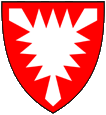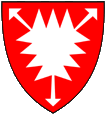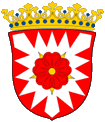Schaumburg-Lippe |
|
|
|
| Übersicht – Contents: | |
Diese Seite ist Teil des Projektes
Schaumburg-Lippe |
|
|
|
| Übersicht – Contents: | |
Flaggen – Flags: |
|
 |
bis/to 1934, Landesfarben und Staatsflagge – colors of the country and official flag, Quelle/Source: World Statesmen |
 |
1880–1911, Flagge des Fürsten – flag of the Prince Quelle/Source: Flags of the World, Deutsche Wappen Rolle |
 |
1911–1918, Flagge des Fürsten – flag of the Prince Quelle/Source: Flags of the World |
 |
heutige Zeremonialflagge am Schloss Bückeburg – today's ceremonial flag at Bückeburg Castle, Quelle/Source: Dr. Lichtblau |
 |
1946–1977, Flagge Kreis Schaumburg-Lippe – Flag of the District of Schaumburg-Lippe, Quelle/Source: Dr. Lichtblau |
 |
seit/from 1977, |
|
|
|
Bedeutung/Ursprung der Flagge – Meaning/Origin of the Flag: |
|||||||
| Die Landesfarben von Schaumburg-Lippe waren Weiß, Rot und Blau, jedoch erst 1922 offiziell festgelegt und eingeführt. | The colours of Schaumburg-Lippe were white, red and blue, but they were not before 1922 officially defined and introduced. | ||||||
| Es gibt für den Zeitraum vor 1880 Darstellungen der Flagge in einer farblichen Umkehrung in Blau, Rot und Weiß, die jedoch durch einen Fehler der damaligen Düsseldorfer Herstellerfirma begründet sind. | There
exist representations of the flag in a color reversal in blue, red and
white, for the period before the year 1880. They are justified by a failure of the former Düsseldorf manufacturer. |
||||||
| Wahrscheinlich sind die Landesfarben vom Wappen der Grafschaft Schaumburg abgeleitet, silbernes (weißes) Nesselblatt auf Rot, das manchmal von einem blauen Rand umgeben dargestellt wurde. Ebenso könnten sich die Hausfarben des Hauses Lippe-Alverdissen dahinter verbergen, von denen das Haus Schaumburg-Lippe abstammt. Das mittlere Wappen von Schaumburg-Lippe zeigte einen roten Herzschild, in dessen Mitte oft ein kleinerer Schild erscheint, der manchmal die Farben Silber und Rot zeigt, manchmal aber auch Blau und Rot, der für die Hausfarben des Herrscherhauses stehen könnte. | Probably
the colours are derived from the coat of arms of the County of Schaumburg, a
silvery (white) nettle leaf on red, which was sometimes depicted with a blue
border. It is further possible that the house-colors of the House of Lippe-Alverdissen could hide behind it, from which the House of Schaumburg-Lippe descents. The middle coat of arms of Schaumburg-Lippe showed a red central-shield, in its middle often appeared a smaller shield that sometimes shows the colors silver and red, sometimes even blue and red, which could could stand for the house-colours of the ruling family. |
||||||
| Ein für die Flagge bedeutsames Ereignis war die Machtergreifung durch die Nationalsozialisten im Deutschen Reich im Jahre 1933. Alle offiziellen Nicht-Hakenkreuz-Flaggen die auf den Föderalismus, regionale Bezüge oder das Kaiserreich zurückgingen wurden zwischen 1933 und 1935 abgeschafft. | Another
incident for the flag was the seizure of power by the National Socialists
in the German Empire in 1933. All official non-swastika flags, that refered to federalism, regional references or the old German Empire were abolished between 1933 and 1935. |
||||||
|
Für die Nationalsozialisten galten die föderale Struktur des Deutschen
Reiches, seine historisch gewachsenen Länder, als überholt, als Relikte
einer zu überwindenenden Vergangenheit.
In diesem Sinne wurden mehrere Gesetze erlassen, am 31.03.1933 das 'Vorläufige Gesetz zur Gleichschaltung der Länder mit dem Reich', am 07.04.1933 das 'Zweite Gesetz zur Gleichschaltung der Länder mit dem Reich' und schließlich, am 30.01.1934 das 'Gesetz über den Neuaufbau des Reiches'. Die föderale Länder-Struktur des Deutschen Reiches wurde damit durch die Gaue der NSDAP abgelöst, die Länder wurden bedeutungslos. Ämter und Behörden hatten ab jetzt die Hakenkreuzflagge als Dienstflagge zu verwenden, und zwar bis zum 15. September 1935, als mit dem Reichsflaggengesetz eine Dienstflagge für alle Ämter und Behörden des Reiches geschaffen wurde. Die Ministerpräsidenten der Länder, ab spätestens 1933 alle von der NSDAP – und dann meist Reichsstatthalter genannt – blieben jedoch bis 1945 im Amt. |
For the National Socialists, the federal structure of the German Empire,
its historically grown countries, was considered as outdated, as relics
of a past to be overcome. In this sense, several laws were enacted, on 31st of March in 1933 the 'Provisional Law for the phasing of the countries with the Empire', on 7th of April 1933 the 'Second Law for the phasing of the countries with the Empire' and finally, on 30th January in 1934 the 'Law on the rebuilding of the empire'. Thus, the federal structure of the German Empire was replaced by the gau-structure of the NSDAP, the countries became meaningless. From now on, offices and authorities had to use the swastika flag as official flag, until September 15th in 1935, when by the flag-law was legislated a new created official flag for all the offices and authorities of the empire. The prime ministers of the countries, which latest in 1933 all came from the NSDAP – now mostly called Reichsstatthalter (maybe translated as 'governor') – however remained in office until 1945. |
||||||
| Die entsprechenden Landesfarben galten mit Einschränkungen zwar weiter, auf jeden Fall aber nicht in Form von Flaggen. Sie wurden z.B. vereinzelt an Uniformen der SA oder bei bestimmten Dienstgraden der Hitlerjugend in der Brustschnur verwendet. | The
corresponding country colours continued, with restrictions, but definitly not
in the form of flags. They were used, for example, occasionally on uniforms
of the SA or in some ranks of the Hitler Youth in the breast cord.
| Nach
dem Krieg wurde die Verwaltung innerhalb des Deutschen Reiches neu aufgebaut,
und zwar lokal, über die Struktur der Länder. Das waren teilweise alte Länder,
teilweise wurden neue Länder geschaffen. Dabei besann man sich oft der alten
Landesfarben und reaktivierte sie – oder man schuf neue – für eingeschränkte
hoheitliche Aufgaben, die der Kontrolle durch die Alliierten unterstanden.
Mit der Gründung der BRD und der DDR
wurde für beide Gebilde eine interne Länderstruktur final festgelegt und es
wurden entsprechende offizielle Flaggen für die Länder eingeführt.
| After
the war, the administration within the German Empire was rebuilt, but locally,
following the structure of the countries. | These have been partly old countries, and some new countries were created. Sometimes they bethought the old country colours and reactivated them – or they created new ones – for limited sovereign duties, which were under the control of the Allies. With the founding of the FRG and the GDR, an internal country-structure was finalised for both entities and corresponding official flags were introduced for these countries.
Quelle/Source:
Flags of the World,
World Statesmen,
Volker Preuß, Dr. Lichtblau,
Jürgen Kaltschmitt,
Uniform-Fibel |
| |||
Wappen – Coat of Arms: |
|
 |
Wappen der Grafen von Schaumburg – coat of arms of the Counts of Schaumburg, Quelle/Source nach/by: Wikipedia (D) |
 |
13.
Jhd./cent.–1601, Wappen der Grafschaft Schaumburg – coat of arms of the County of Schaumburg, Quelle/Source nach/by: Wikipedia (D) |
 |
1601–1807, mittleres Wappen der Grafschaft Schaumburg-Lippe – middle coat of arms of the County of Schaumburg-Lippe, Quelle/Source nach/by: www.heraldique.org |
 |
1807–1904, mittleres Wappen Fürstentum Schaumburg-Lippe – middle coat of arms of the Principality of Schaumburg-Lippe, Quelle/Source nach/by: historische Abbildung |
 |
19.
Jahrhundert/19th century, kleines Wappen Fürstentum Schaumburg-Lippe – lesser coat of arms of the Principality of Schaumburg-Lippe, Quelle/Source nach/by: historische Abbildung |
 |
19.
Jahrhundert/19th century, kleines Wappen Fürstentum Schaumburg-Lippe – lesser coat of arms of the Principality of Schaumburg-Lippe, Quelle/Source nach/by: historische Abbildung |
 |
1904–1918, kleines Wappen Fürstentum Schaumburg-Lippe – lesser coat of arms of the Principality of Schaumburg-Lippe, Quelle/Source nach/by: Brockhaus Konversationslexikon |
 |
1904–1918, mittleres Wappen Fürstentum Schaumburg-Lippe – middle coat of arms of the Principality of Schaumburg-Lippe, Quelle/Source nach/by: historische Abbildung |
 |
1918–1946, Wappen Freistaat Schaumburg-Lippe – coat of arms of the Free State of Schaumburg-Lippe, Quelle/Source nach/by: png erstellt von N3MO / Public domain |
 |
seit/since 1977, Wappen Kreis Schaumburg – coat of arms of the District of Schaumburg, Quelle/Source nach/by: www.schaumburg.de |
Bedeutung/Ursprung des Wappens – Meaning/Origin of the Coat of Arms: |
|
| Ein wichtiger Bestandteil der Wappen des Landes war das silberne Nesselblatt auf Rot, die Heraldik der alten Grafschaft Schauenburg, die 1647, nach dem Aussterben der Grafen von Schauenburg (ab 1485 Schaumburg genannt), an das Haus Lippe-Alverdissen kam. Schon im 13. Jahrhundert wurden die Ecken des Nessblatts sehr ausdrucksstark dargestellt, und sogar als Nägel gedeutet. Graf Adolf IV. nahm im Jahre 1238 an einem Kreuzzug nach Livland teil. Eine Legende behauptet, dass er die Ecken seines Wappens als Nägel ausführen ließ, um an die drei Nägel vom Kreuze Jesu Christi zu erinnern, und so seine Frömmigkeit darzustellen. Wenn es eine Legende ist, so hat sie doch ihre Spuren hinterlassen, denn bis weit in das 19. Jahrhundert hinein wurden die drei Nägel im Wappen gezeigt. | An
important component of the coat of arms of the country was the silvery
nettle leaf on red, the heraldry of the ancient County of Schauenburg, which
came in 1647 to the House of Lippe-Alverdissen, after the extinction of the
Counts of Schauenburg (from 1485 called Schaumburg). Already in the 13th
century the corners of the nettle leaf were reproduced very expressive, and
even interpreted as nails. Count Adolf IV. in 1238 was a participant in a crusade in Livonia. A legend claims that he had ordered to reproduce the corners of his arms as nails, to commemorate the three nails on the cross of Jesus Christ, and in thus to represent his piety. If it is a legend, it has nevertheless left its mark, because deep into the 19th century the three nails were shown in the coat of arms. |
| Als die Line Lippe-Alverdissen im Jahre 1647 die Grafschaft Schaumburg übernahm, wurde auf das Wappen des Hauses Lippe als Herzschild Wappen der Grafschaft gelegt, mit einem silbernen, stilisierten Nesselblatt und drei silbernen Nägeln auf Rot, jedoch befindet sich in der Mitte des Nesselblatt noch ein kleiner Schild, der wahrscheinlich die Hausfarben des Hauses Lippe-Alverdissen zeigt, Weiß und Rot, manchmal jedoch auch Blau und Rot. Dieser Herzschild wurde als keines Wappen von Schaumburg-Lippe geführt, und in der Praxis sehr oft verwendet, jedoch zeigte der kleine Schild auf dem Nesselblatt dann noch eine 'Lippische Rose', manchmal allein auf Silber, manchmal, wenn der kleine Schild die Farben Silber (Weiß) und Rot zeigte, auch im weißen Feld. | When the
Line of Lippe-Alverdissen in 1647 took over the County of Schaumburg, was
put on the coat of arms of the House of Lippe the coat of arms of the county
as a central shield, with a silvery, stylized nettle leaf and three silvery
nails on red, but there is placed in the middle of the nettle leaf a further
small shield, which probably shows the house colors of the House of
Lippe-Alverdissen, white and red, but sometimes even blue and red. This central shield was used as small coat of arms by Schaumburg-Lippe, and in practice very often used in this way, but then showed the little shield on the nettle leaf even the 'Lippe Rose', sometimes alone in silver, sometimes, when the small shield showed the colors silver (white) and red, also in the white field. |
| Auch die zeigte Fürstenkrone über die Jahre sehr unterschiedliche Ausführungen, mal als Fürstenhut, mal als Krone, ab 1904 sogar als Königskrone. In jenem Jahr wurde das Wappen per Gesetz festgelegt: die Nägel in den Ecken des Nesselblatts wurden abgeschafft, und im kleinen Wappen die 'Lippische Rose' unmittelbar auf das Nesselblatt gelegt. Der Freistaat Schaumburg-Lippe hat das kleine Wappen übernommen, jedoch wurde die Fürstenkrone entfernt und durch die 'Volkskrone' ersetzt. Der Kreis Schaumburg verzichtet auf die Krone und die 'Lippische Rose', jedoch ist das Wappen von einem blauen Rand umgeben, was von Zeit zu Zeit immer mal wieder gemacht wurde, und so an die Landesfarben Weiß, Rot und Blau erinnert. | Also the
prince's crown showed over the years very different designs, sometimes as a
princely hut, sometimes as a crown, and from the year 1904 even as the royal
crown. In that year the coat of arms was fixed by law: the nails in the
corners of the nettle leaf were abolished, and in the small coat of arms the
'Lippe Rose' was placed directly on the nettle leaf. The Free State of Schaumburg-Lippe took over the small coat of arms, however, the prince's crown became replaced by the 'People's crown'. The District of Schaumburg waives the crown and the 'Lippe Rose', but the crest is surrounded by a blue border, which has been showed from time to time in this way, and so reminiscent to the colours of the country, white, red and blue. |
|
Quelle/Source: Schaumburg.de,
Hubert Herald,
Volker Preuß Quelle/Source: Verordnung betreffend das Fürstlich Schaumburg-Lippische Staatswappen vom 27. Mai 1904 |
|
Kokarde – cockade: |
|
 |
bis/to 1919, Kokarde – cockade, Quelle/Source nach/by: historische Abbildung |
|
Lesen Sie hier: Hintergründe, Geschichte und Fakten zum Thema "Kokarden". |
 Kokarde / Cockade |
read here: Informations, history and facts about the theme "Cockades". |
Landkarte – Map: |
|
|
|
| Die Landkarte zeigt das Fürstentum Schaumburg-Lippe ca. 1865 in dünner roter Umrandung, südöstlich davon, in lilafarbener Umrandung der (damals) hessische 'Kreis Grafschaft Schaumburg-Lippe' | The map shows the Principality of Schaumburg-Lippe ca. 1865 within a thin red border, in the southeast of it, within a lila-colored border of the (then) Hessian 'District County of Schaumburg-Lippe' |
Zahlen und Fakten – Numbers and Facts: |
|
|
|
|
|
|
|
|
|
|
|
Geschichte: |
|
12. Jahrhundert · erste Erwähnung der Herren von Schauenburg 1110 · die Herren von Schauenburg werden mit Holstein belehnt 1295 · die Herren von Schauenburg werden in den Reichsgrafenstand erhoben ca. 1485 · der Name Schauenburg wird offiziell erstmals als Schaumburg erwähnt 1640 · Tod von Graf Otto V. von Schaumburg, er hinterlässt keine Erben 1644 · das Erbe geht an Graf Philipp zur Lippe-Alverdissen (Bruder der Mutter von Otto) 1646 · Tod der Mutter von Otto, Erbteilung, die Grafschaft Holstein-Pinneberg geht an Christian IV. von Dänemark, Gehmen (Westfalen) geht an den Herzog von Limburg, die Grafschaft Sternberg geht an die Grafen von Lippe, Bergen (Holland) wird verkauft; die Grafschaft Schaumburg wird 1647 aufgeteilt: Lauenau, Mesmerode und Bokeloh gehen an Braunschweig-Lüneburg; Schaumburg, Rodenberg und Sachsenhagen gehen als 'Kreis Grafschaft Schaumburg' an die Landgrafschaft Hessen; Bückeburg, Arensburg, Stadthagen und Hagenburg werden zur Grafschaft Schaumburg-Lippe unter einer Nebenlinie des Hause Lippe-Alverdissen zusammengefasst 1681 · Tod von Philipp von Schaumburg-Lippe-Alverdissen, das Erbe wird zwischen beiden Söhnen aufgeteilt, Friedrich Christian übernimmt Schaumburg-Lippe, Philipp Ernst die Linie Lippe-Alverdissen 1777 · Tod von Wilhelm von Lippe-Alverdissen, das Erbe geht an Schaumburg-Lippe 1792, 1796, 1800 und 1805 · Invasionen französischer Revolutionstruppen unter Napoléon in das Deutsche Reich, das Deutsche Reich unterliegt und wird von Napoléon territorial umgestaltet 1803 · Reichsdeputationshauptschluss, Umgestaltung der territorialen Gliederung des Deutschen Reiches, geistliche Besitzungen werden enteignet, alte Fürstenterritorien und freie Städte werden enteignet oder aufgehoben und alten oder neuen Fürstentümern übertragen, die Zahl der Gebietskörperschaften des Reiches wird dadurch von 300 auf 60 reduziert 12.07.1806 · Napoléon erzwingt die Gründung des Rheinbundes, ein Zusammenschluss von sechzehn süd- und südwestdeutschen Staaten unter französischem Protektorat 01.08.1806 · die Staaten des Rheinbunds treten aus dem Heiligen Römischen Reich Deutscher Nation aus 06.08.1806 · Kaiser Franz II. legt die Krone des Heiligen Römischen Reiches Deutscher Nation nieder, das Reich endet 18.04.1807 · Schaumburg-Lippe tritt dem Rheinbund bei, Erhebung des Grafen von Schaumburg-Lippe in den Fürstenstand Oktober 1813 · Niederlage Napoléons bei Leipzig, der Rheinbund beginnt zu zerfallen, Napoléon und seine Truppen ziehen sich hinter den Rhein zurück 1814–1815 · Wiener Kongress, Neuordnung Europas nach der Ära Napoléon, die Besitzverhältnisse und die Raumordnung im ehemaligen Deutschen Reich werden wieder hergestellt, jedoch nicht die Souveränität der geistlichen Länder, deren Besitzungen werden alten oder neuen Fürstentümern übertragen oder angeschlossen, die 39 verbleibenden deutschen Staaten – so auch Schaumburg-Lippe – werden in einem lockeren Zusammenschluss, dem Deutschen Bund organisiert 1866 · Deutscher Krieg (Bruderkrieg) Preußens und seiner Verbündeten gegen Österreich und seine Verbündeten, Preußen siegt, das Fürstentum Schaumburg-Lippe steht auf der Seite Preußens, Beitritt zum Norddeutschen Bund, der hessische Kreis Grafschaft Schaumburg wird Teil der preußischen Provinz Hessen-Nassau 1868 · Einführung einer Verfassung 1871 · Beitritt des Fürstentums Schaumburg-Lippe zum Deutschen Reich 15.11.1918 · Sturz der Monarchie, Schaffung des Freistaats Schaumburg-Lippe 1932 · der Kreis Grafschaft Schaumburg wird der Provinz Hannover angeschlossen 1934 · die territoriale Länder-Struktur des Deutschen Reiches wird durch die Gaue der NSDAP abgelöst, die Länder werden bedeutungslos 1945 · Besetzung durch britische und US-amerikanische Truppen 01.11.1946 · Auflösung des Freistaats Schaumburg-Lippe, Schaumburg-Lippe wird als Kreis Schaumburg-Lippe dem Land Niedersachsen angegliedert (Schaumburg-Lippe, Hannover, Braunschweig und Oldenburg) 19.01.1975 · ein Volksentscheid zugunsten der Wiederherstellung des Landes Schaumburg-Lippe wird abgewiesen 01.08.1977 · der Kreis Schaumburg-Lippe (Stadthagen) wird mit dem Kreis Grafschaft Schaumburg (Rinteln) zum Kreis Schaumburg vereinigt |
History: |
|
12th century · first mention of the Lords of Schauenburg 1110 · the Lords of Schauenburg get Holstein as fiefdom 1295· the Lords of Schauenburg get levied to Imperial Counts ca. 1485 · the name Schauenburg is officially first mentioned as Schaumburg 1640 · death of Count Otto V. of Schaumburg without heirs 1644· the heritage goes to Count Philipp of Lippe-Alverdissen (brother of the mother of Otto) 1646 · death of the mother of Otto, inheritances, the County of Holstein-Pinneberg goes to Christian IV. of Denmark, Gehmen (Westphalia) goes to the Duke of Limburg, the county Sternberg goes to the Counts of Lippe, Bergen (Netherlands) is sold, the County of Schaumburg becomes divided in 1647: Lauenau, Mesmerode and Bokeloh go to Brunswick-Lueneburg, Schaumburg, Rodenberg and Sachsenhagen go as 'District of County Schaumburg' to the Landgraviate of Hesse; Bueckeburg, Arensburg, Stadthagen and Hagenburg become summarized as County of Schaumburg-Lippe under a branch of the family-line of the House of Lippe-Alverdissen 1681 · death of Philip of Schaumburg-Lippe-Alverdissen, the inheritance is divided between the two sons, Friedrich Christian takes Schaumburg-Lippe, Philipp Ernst, the line of Alverdissen 1777 · death of William of Lippe-Alverdissen, the inheritance goes to Schaumburg-Lippe 1792, 1796, 1800 and 1805 · invasions of French revolutionary troops under Napoleon in the German Empire, the German Empire subjectes and becomes territorially transformed 1803 · German Mediatisation (Reichsdeputationshauptschluss), transformation of the territorial partition of the German Empire, ecclesiastical possessions become confiscated, old princely territories and free cities become confiscated or dissolved or annexed to old or new principalities, the number of sovereign authorities and territorial entities of the empire is thus reduced from 300 to 60 12th of July in 1806 · Napoleon forces the creation of the Rhine Confederation, an alliance of sixteen southern and southwestern German states under French protectorate 1st of August 1806 · the states of the Rhine Confederation declare themselves sovereign and resign from the Holy Roman Empire of German Nation 6th of August in 1806 · Emperor Franz II. lays down the crown of the Holy Roman Empire of German Nation, the empire ends 18th of April in 1807 · Schaumburg-Lippe joins the Rhine Confederation, the Count of Schaumburg-Lippe becomes levied to the rank of a Prince October 1813 · Napoleon's defeat at Leipzig, the Rhine Confederation begins to fall apart, Napoleon and his troops withdraw behind the Rhine River 1814–1815 · Congress of Vienna, reconstruction of Europe after the era of Napoleon, the ownership and the administrative partitions in the former German Empire become restored, but not the sovereignty of the ecclesiastical countries, their possessions become transferred to old or new principalities, the 39 remaining German states – in this way Schaumburg-Lippe too – become organized in a loose association, the German Confederation 1866 · German war (civil war), Prussia and its allies against Austria and its allies, Prussia wins, the Principality of Schaumburg-Lippe is on the side of Prussia, join of the North German Confederation, the Hessian 'District of County Schaumburg' becomes a part of the Prussian Province of Hesse-Nassau 1868 · introduction of a constitution 1871 · joining of the Principality of Schaumburg-Lippe to the German Empire 15th of November in 1918 · overthrow of the monarchy, establishing of the Free State of Schaumburg-Lippe 1932 · the 'District of County Schaumburg' becomes annexed to the Province of Hanover 1934 · the territorial structure of the states of the German Empire becomes replaced by the districts of the NSDAP, the countries become meaningless 1945 · occupation by British and American troops 1st of November in 1946 · dissolution of the Free State of Schaumburg-Lippe, Schaumburg-Lippe becomes annexed as District of Schaumburg-Lippe to the Country of Lower Saxony (Schaumburg-Lippe, Hanover, Brunswick and Oldenburg) 19th of January in 1975 · a referendum for the restoration of the Country of Schaumburg-Lippe is dismissed 1st of August in 1977 · the District of Schaumburg-Lippe (Stadthagen) becomes merged with the District of County Schaumburg (Rinteln) to the District of Schaumburg |
| Quelle/Source: hubert-herald.nl, Wikipedia (D), Volker Preuß |
Ursprung des Landesnamens – Origin of the Country's Name: |
|
| Der Name des Landes geht auf die Schauenburg zurück, den Stammsitz der Herren von Schauenburg. Gegen Ende des 15. Jahrhunderts wurde der Name Schauenburg zu Schaumburg abgeschliffen, und hat sich so auf das Land und die Herrscherfamilie aus dem Haus Lippe übertragen. | The name of the country goes back to the Schauenburg Castle, the ancestral seat of the Lords of Schauenburg. Towards the end of the 15th century the name Schauenburg was abraded to Schaumburg, and became transferred in this way to the country and the ruling family of the House of Lippe. |
| Quelle/Source: Wikipedia (D) | |
|
Mit freundlicher Untersützung von: Kindly supported by: |
Dr. Lichtblau (D) |